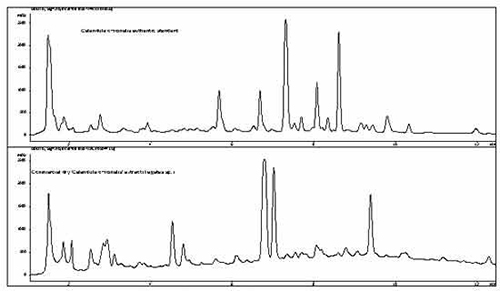Herbal Authentication: Case Study
Herbal Authentication: Case Study
A sponsor submitted a dry extract of Calendula officinalis for authentication. The extract was produced by an overseas manufacturer. At the same time, the sponsor had a sample of the raw material from which the extract was made sent by the manufacturer directly to the Medicinal Plant Herbarium.
Comparative high-performance liquid chromatography (HPLC) analysis of an authentic Calendula officinalis sample (top) and the commercial sample (bottom) at the Centre for Phytochemistry and Pharmacology showed very significant differences in chemical profile. These differences were of a magnitude clearly indicating that the commercial sample was not a Calendula officinalis extract.

Macroscopic examination of the raw material provided by the manufacturer (below left) confirmed that the extract was not prepared from Calendula officinalis (below right), but rather from a species of Tagetes.
Although the commercial extract was clearly labelled '; officinalis', it is possible that the common name 'marigold' might have been partly responsible for the erroneous identification of the raw material by the extract manufacturer. Both Calendula and Tagetes species are known as 'marigold', the latter normally as Asian or African marigold.

/prod01/channel_8/media/scu-dep/current-students/images/Coffs-harbour_student-group_20220616_33.jpg)
/prod01/channel_8/media/scu-dep/current-students/services/counselling/images/RS21533_English-College-Student_20191210_DSC_6961.jpg)
/prod01/channel_8/media/scu-dep/study/scholarships/images/STEPHANIE-PORTO-108-2.jpg)
/prod01/channel_8/media/scu-dep/study/arts-and-humanities/images/RS20958_Chin-Yung-Pang-Andy_20190309__79I5562-960X540.jpg)
/prod01/channel_8/media/scu-dep/experience/images/SCU-INTNL-STUDY-GUIDE-280422-256.jpg)
/prod01/channel_8/media/dep-site-assets/component-library/screenshots/online-1X1.jpg)